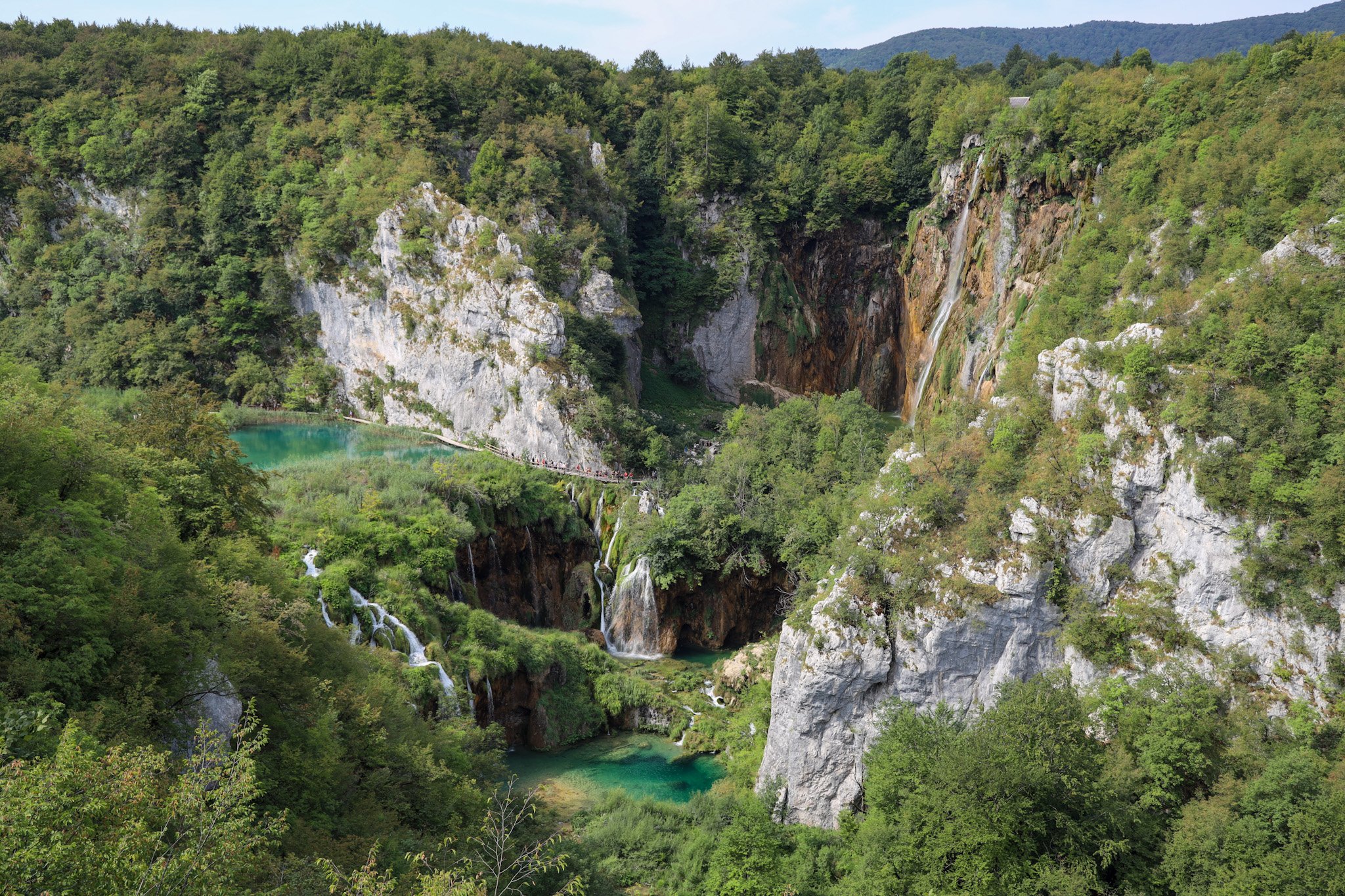
PLITVICE LAKES NATIONAL PARK
INTRO
Plitvice Lakes National Park makes it on almost any itinerary to Croatia, and it only makes sense as to why. The park has a fairytale-like feel; the landscape is dotted with turquoise lakes that cascade through travertine rock barriers, creating waterfalls of all sizes everywhere you look. It’s Croatia’s oldest and largest national park, as well as a UNESCO World Heritage Site.
That being said, the crowds are HUGE — over 1 million visitors explore the park each year, making it the single most popular tourist attraction in all of Croatia. We visited the park in August and waited in quite a few hour-long lines a day to get around the park's shuttle, ferry system, and narrow boardwalks. In our opinion, it’s fully worth braving the crowds for, but plan ahead and go early in the day to make the most of your time at the park!
WHAT YOU NEED TO KNOW
Duration: 2-4 days. This should give you enough time to explore the lakes in full!
When to go: The best months for good weather are June to September, with July and August being the busiest.
Accommodations + facilities: There are many hotels, guesthouses, and Airbnbs, as well as a couple campgrounds, all around the park. For camping, we’d recommend Camp Korana. Especially if you don’t have a car, this campsite is awesome because it has a free shuttle to the park that leaves at 9am and returns at 5pm every day. If you’re looking for an Airbnb, we stayed here — we were traveling with a friend who didn’t have a tent, so this was the most affordable option we found for a group of 3! The Airbnb is about 5 miles from Entrance 1 of the park, or a 20 minute walk from Camp Korana, where the free bus leaves from. Wherever you decide to stay, make sure to book early if you are traveling to Plitvice during the high season!
Food + water: The park has quite a few shops and restaurants throughout it where you can buy meals, drinks, snacks, etc. That being said, they did seem to be pretty up-charged, so if you’re on a tight budget, we’d recommend packing food from one of the local markets outside the park.
Guide or no guide: No guide needed. Given the crowds, the park asks visitors to follow a few one-directional, very well-signed loop routes throughout the park. See below under “Things to Do” for more info on these loops.
Difficulty: Most of the routes around Plitvice Lakes are flat and on well-maintained boardwalks, so for the most part, the walking is not too challenging! It can get super hot though, so definitely plan ahead and stay hydrated.
Make sure you have: Your tickets purchased online ahead of time — you’ll save lots of time not waiting in the long ticket line and guarantee your entry at the time you want! You can buy them here.
Primary costs: The major costs for Plitvice Lakes National Park are as follows:
Park entry ticket: you can buy 1-day or 2-day tickets. The prices vary by time of year, with the most expensive being during the high season (June to September). A 2-day ticket when we went was about 60 euros (65 USD). You can see the full price list here.
Airbnb: We visited Plitvice with a friend and booked a room in this Airbnb — for 4 nights, the cost for all 3 of us was 273.84 USD, or ~91 USD per person.
Transit: Your park ticket includes ferry and shuttle rides throughout the park, so this was free!
THINGS TO DO
Given the park’s popularity, visitors’ movement throughout the park is pretty controlled. There are 8 circular routes (also called loops and programs) that you can follow to explore the park’s lakes and waterfalls. 4 of the routes start from Entrance 1, and 4 start at Entrance 2. Some of the routes also include a shuttle or ferry ride. They are all really well-signed, so don’t worry too much about getting off track! See here for a detailed list of each of the routes. Most of the routes are on boardwalks, so while it can be hot, the walking itself is pretty easy. Across our three days in the park, we covered almost all the ground within the 8 loops.
In addition to the 8 loops, there are 4 hiking trails. These trails are much quieter and go through the forest surrounding the lakes. They aren’t super challenging, but are more typical hiking trails (uneven terrain with up and downhill sections) than the boardwalk loop paths.
GETTING THERE
It’s easy to get to most places in Croatia by bus, and Plitvice is no exception. The closest major cities to Plitvice are Zadar and Zagreb, and you can book a bus to the park from these cities online on FlixBus or Arriva. Some people even see the park as a day trip from Zadar or Zagreb, though it does require quite a bit of travel time. If you’re traveling from elsewhere in Croatia (or other major European cities), it’s also easy to catch a bus to the park — use FlixBus or Arriva to plan your route and book your tickets. You can also rent a car in any major city and drive to Plitvice, which many people opt to do.
There are quite a few towns surrounding Plitvice, so once you’re in the area, to get to the park, you’ll either need to be staying close enough to walk, have a car, or have an accommodation that includes transportation. There are two entrances to the park (named the ever-thrilling Entrance 1 and Entrance 2), about 3km away from each other. Both entrances have paid parking available for visitors.
Last updated: 6 August 2022




